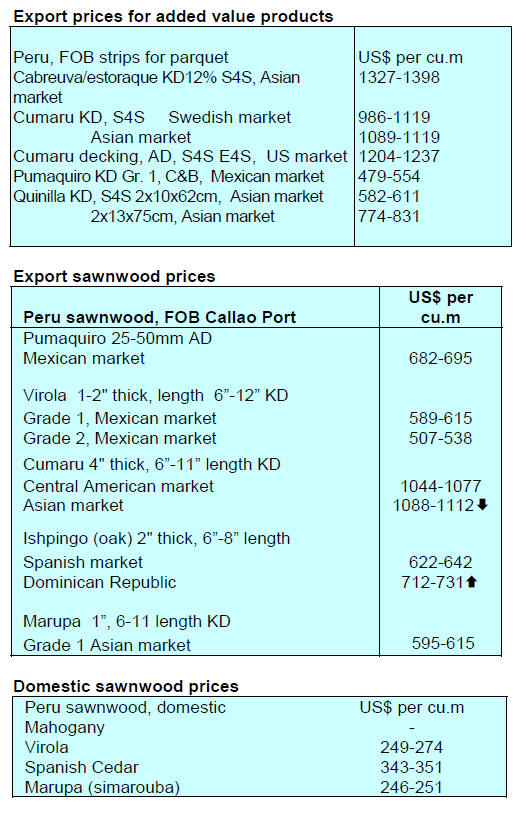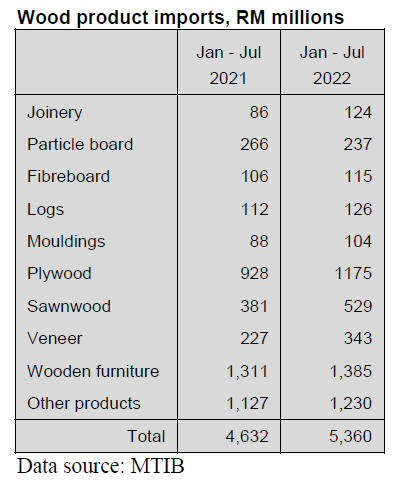
4.
INDONESIA
Indonesia publishes FLEGT study
The Indonesian government has published a study on the
implementation of forest law enforcement, governance,
and trade (FLEGT) as part of efforts to support the
eradication of illegal logging and boost legal timber trade.
This study provides an overview of market acceptance,
recognition, perception, and incentives, particularly the
European market for FLEGT-licensed timber said the
Director General of Sustainable Forest Management, Agus
Justianto. The study is an important milestone in
understanding global policies related to product legality
and forest sustainability in forest products trade, he added.
The study provides an overview of developments in
producing countries besides Indonesia on developing,
negotiating and implementing FLEGT VPA, especially in
consumer country policies.
The study was carried out by a team from the University
of Freiburg in Germany and the Sebijak Institute of Gajah
Mada University with financial support from the
Indonesian Embassy for the Federal Republic of Germany
and the United Kingdom government.
See:
https://en.antaranews.com/news/251497/indonesiapublishes-flegt-study-to-support-legal-timber-trade
and
https://nasional.kontan.co.id/news/kajian-implementasi-flegtdan-implikasi-kebijakan-global-legalitas-kayu-dirilis
Encouraging equality in forest management
certification
Silverius Oscar Unggul, Deputy Chairman of the
Indonesian Chamber of Commerce and Industry (Kadin)
for Environment and Forestry, said Indonesia hopes that
the members of the Forest Stewardship Council (FSC) can
agree on Motion 37/2021 to provide equality to forestry
business actors in the world in sustainable forest
development at all business scales.
FSC discussed Motion 37/2021 at the General Assembly
in Bali, 9-14 October 2022 and one of the important points
in this motion is the change in the cut-off date – the
deadline for authorised natural forest conversion into
forest plantations - from November 1994 to December 31,
2020.
The November 1994 cut-off date, said Silverius Oscar, has
so far been considered an obstacle in the application of
FSC certification for plantation forests in Indonesia.
He also said that business actors in Indonesia of various
scales, from large scale to the community scale, deserve
the opportunity to participate in the FSC certification
scheme so that they can enter markets that require FSC
certification.
See:
https://forestinsights.id/2022/09/27/indonesia-dorongkesetaraan-dalam-sertifikasi-pengelolaan-hutan/
and
https://ekonomi.bisnis.com/read/20220930/9/1583012/kadinaphi-dorong-kesetaraan-dalam-sertifikasi-pengelolaan-hutanlestari
Indonesia/UK VPA – should benefit environment and
communities
The Indonesian House of Representatives has approved
the Ratification of the Voluntary Partnership Agreement
between the Indonesian Government and the United
Kingdom. This was stated in a Working Meeting between
the Ministry of Environment and Forestry, Ministry of
Trade, Ministry of Law and Human Rights and Ministry of
Foreign Affairs.
Regarding the ratification, Commission VI member Deddy
Yevri Hanteru Sitorus, emphasised that the ratification
should be of special concern to the Ministry of
Environment and Forestry because, even though the
FLEGT-VPA has a large economic impact, it is still
necessary to pay attention to its effect on the existing
forests. Deddy said that he hopes the FLEGT-VPA will
not only stimulate the economy but also take into
consideration the environment and benefits for
communities.
See:
https://www.dpr.go.id/berita/detail/id/41060/t/javascript;
Export benchmark prices for October wood products
The government released the Export Benchmark Price
(HPE) for wood products for October 2022. This was
stated in the Decree of the Minister of Trade Number 1372
of 2022 which was issued on September 30, 2022.
In a press statement it was explained that in October there
is a change in the HPE for wood sheet products for
packing boxes from plantation forests and chipwood.
The press release says "In wood products, there is a
change in HPE, namely wooden sheet products for
packing boxes from plantation forests which increased by
US$50 from the previous month to US$900 /cu.m. The
HPE for chipwood products also increased to US$95/cu.m.
The following are the HPE for wood products which are
valid in October 2022.
Veneers
Natural Forest Veneer US$850/cu.m; Plantation Forest
Veneer US$550/cu.m; Wooden Sheet US$900/cu.m
Chipwood
Chipwood in the form of particles US$90/tone; Chipwood
US$95/tonne
Processed Wood
Processed wood products which are leveled on all four
sides so that the surface becomes even and smooth with
the provisions of a cross-sectional area of 1000 mm2 to
4000 mm2 (ex 4407.11.00 to ex 4407.99.90
Meranti (Shorea sp) US$900/cu.m
Merbau (Intsia sp) US$1.100/cu.m
Rimba Campuran (Mixed tropical wood) US$850/cu.m
Eboni US$3.200/cu.m
Teak US$1.500/cu.m
Pine and Gmelina US$700/cu.m
Acacia sp US$70/cu.m
Sengon (Paraserienthes falcataria) US$450/cu.m
Rubberwood US$300/cu.m
Balsa (Ochroma sp) Eucalyptus, US$600/cu.m
Sungkai (Peronema canescens) US$350/cu.m
Processed wood products which are leveled on all four
sides so that the surface becomes even and smooth from
merbau wood (Intsia sp) with a cross-sectional area of
more than 4000 mm2 to 10000 mm2 (ex 4407.29.91 and
ex 4407.29.92): US$1,200/cu.m
See:
https://forestinsights.id/2022/10/02/harga-patokan-eksporhpe-produk-kayu-periode-bulan-oktober-ada-kenaikan-untuksejumlah-produk/
Multi-business scheme will not negatively impact
forests
The Ministry of Environment and Forestry (KLHK) has
asserted that the multi-business forestry permit scheme
will not have a negative impact on the condition of forests
in Indonesia.
Agus Justianto, DG of Sustainable Forest Management in
the Ministry said during a “Multi-business - Obstacles and
Solutions” workshop "We can control every permit
because if they cannot fulfill their obligations, the permit
can be revoked. This is one mechanism to keep this
programme running."
The shift from a wood-oriented to a landscape ecosystemoriented
approach to utilise non-forest products through a
forestry multi-business permit scheme requires permit
owners to protect the forestry and land use to avoid
increasing new greenhouse gas emissions.
Agus said the ministry will closely monitor existing
schemes, including regulations. Once entrepreneurs are
granted a permit they will be required to make a business
plan in accordance with the ministry's regulations. After
that the business owners will have to report their annual
work plan which will be monitored and evaluated by the
government, specifically in terms of the management of
forest diversification to prevent damage to forests.
See:
https://en.antaranews.com/news/252385/multi-businessscheme-will-not-affect-forests-negatively-ministry
Indonesia releases document on forestry management
policies
The LHK Ministry has released the report “State of
Indonesia's Forests (SOIFO) 2022”. This is a compilation
of government policies for managing the forestry and
environment sector in 2021–2022. LHK Minister Siti
Nurbaya Bakar said the document also contains all of the
government’s efforts to achieve the Forestry and Other
Land Use (FOLU) Net Sink 2030 target.
Indonesia believes that the FOLU sector can play an
important role in mitigating and adapting to climate
change as well as realising Indonesia’s nationally
determined contribution (NDC) document targets. Hence,
Indonesia is implementing three strategies to achieve the
FOLU Net Sink 2030, namely, sustainable forest
management, environmental governance and carbon
governance.
See:
https://en.antaranews.com/news/253621/indonesia-releasesdocument-on-forestry-management-policies
and
https://www.jpnn.com/news/klhk-meluncrkan-soifo-2022-dokumentasi-kebijakan-mengelola-hutan-lingkungan

5.
MYANMAR
Manufacturing
output drops further
According to the latest data from S&P Global, Myanmar's
manufacturing sector output contracted for the fifth
consecutive month in September. Weak demand because
of rising prices and the weakness of the kyat were to
blame. As business activity declined firms cut back on
purchasing of raw materials.
See:
https://www.pmi.spglobal.com/Public/Home/PressRelease/027cb5a25ef54341aaba4218d609910b
Toyota-Myanmar back in business
Toyota Motor Corp. has begun assembling autos in
Myanmar after a more than year-long delay following the
military takeover in February 2021. The factory in the
Thilawa Special Economic Zone, outside the country´s
biggest city, Yangon, is owned by Toyota and its trading
arm, Toyota Tsusho. Toyota is among more than 100
Japanese and other foreign companies with investments in
Thilawa.
See:
https://www.dailymail.co.uk/wires/ap/article-11307247/Toyota-begins-making-cars-Myanmar-delaycoup.html
Import restrictions and currency woes boosts border
trade
Capital flight and a drop in foreign investment, aid and
remittances have resulted in a foreign currency shortage
and in an effort to balance trade the authorities imposed
import limits.
The World Bank’s Myanmar Economic Monitor says that
over 80% of tariff lines now require import licences, up
from 35% last year. New requirements have been imposed
on consumer products, raw materials, intermediate goods
and machinery. The most common items in the border
trade are diesel and petrol.
See:
https://www.frontiermyanmar.net/en/junta-trade-policiesspark-a-smuggling-revival-at-thai-border/
6.
INDIA
Wholesale price indices
The Office of the Economic Adviser, Department for
Promotion of Industry and Internal Trade has published
wholesale price indices for August 2022.
The annual rate of inflation based on the Wholesale Price
Index was 12.41% in August 2022 compared to August
2021. Inflation in August 2022 was primarily because of
the rise in prices of mineral oils, food products, crude
petroleum and natural gas, basic metals, chemical products
and electricity.
The index for manufacturing increased in August to 143.2
from 143.1 for July 2022. Out of 22 NIC two-digit groups
for Manufactured Products, 12 groups have witnessed an
increase in prices while 10 groups have witnessed a
decrease in price.
The indices for wood panels and sawnwood increased
while the index for veneers fell adding to the decline seen
in July. The explanation for the decline in veener prices is
most likely the weaker demand for veneer in China which
has added considerable volumes becoming available.
Some of the groups that witnessed a decrease in prices
were food products, basic metals, textiles, wood and of
products of wood and cork, rubber and plastics products,
electrical equipment, chemical and chemical products.
See:
https://eaindustry.nic.in/pdf_files/cmonthly.pdf

Rupee at historic low
India could emerge as one of the strongest economies with
7% growth rate in fiscal 2023 according to the Economic
Advisory Council to the Prime Minister. The World Bank
projected 6.5% growth rate for the Indian economy for
2022-23, a drop of one percent from its June 2022
projections, citing the deteriorating international
environment.
What may derail growth prospects is currency volatility.
The Indian rupee fell to a historic low of 82.33 against the
US dollar in early October but not as badly has been seen
for some other currencies.
India to benefit from Global Gateway scheme
India is likely to benefit from the Euro 300 billion fund
announced by the European Union (EU) under its Global
Gateway scheme.
The EU website says “The Global Gateway will deliver
sustainable and high-quality projects, taking into account
the needs of partner countries and ensuring lasting benefits
for local communities.
This will allow EU’s partners to develop their societies
and economies but also create opportunities for the EU
Member States’ private sector to invest and remain
competitive, whilst ensuring the highest environmental
and labour standards, as well as sound financial
management. The Global Gateway is the EU’s
contribution to narrow the global investment gap
worldwide”.
See:
https://ec.europa.eu/info/strategy/priorities-2019-2024/stronger-europe-world/global-gateway_en
Lack of import regulations a risk for timber sector says
Forest Trends
Forest Trends has recently released a report “Turbulent
times for India’s timber trade”. This report. says Forest
Trends. “focuses on recent changes in India’s international
timber trade, especially over the 2019–2021 period, and
the implications (of identified changes) for India’s
sourcing of illegally harvested or traded timber.
The paper provides an update of Forest Trends’ 2020
report India’s Wooden Furniture and Wooden Handicrafts:
Risk of Trade in Illegally Harvested Wood (Norman &
Canby 2020). The findings of the 2020 Forest Trends
report as regards to the long-term timber illegality risk
profile of India’s timber trade remain valid”.
The report continues “Although the illegality risk level of
India’s timber imports has been lower over the 2019–2021
period than the preceding years, this is almost certainly
due to COVID and therefore short-term.
In the absence of timber import regulations the pre-
COVID risk levels will probably be reestablished when
India’s domestic demand picks up this is projected to rise
fast through the 2020s”.
See:
https://www.forest-trends.org/wpcontent/uploads/2022/09/India-TTA-Report-Final.pdf
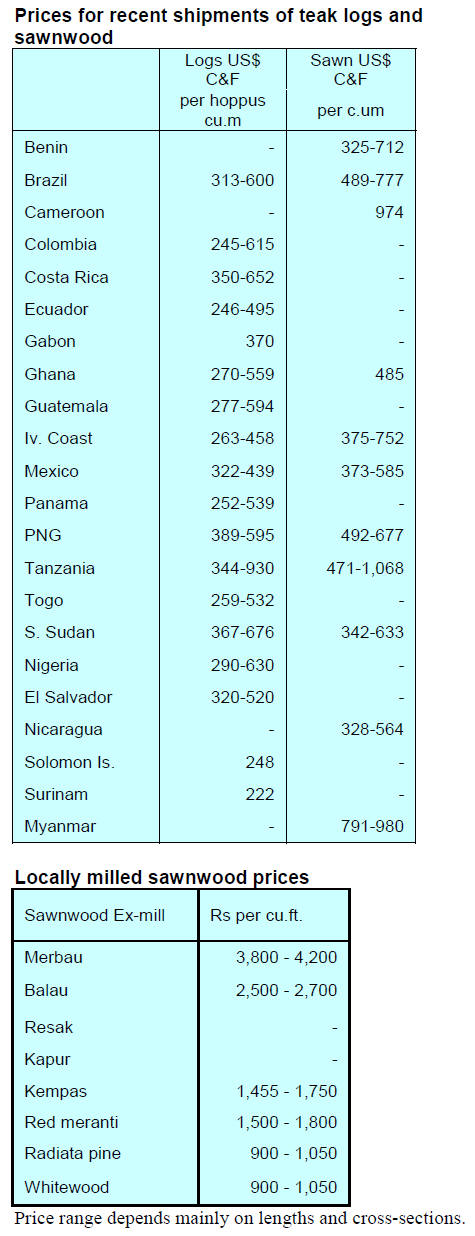
Plywood
Please note plywood prices are now shown below free of
local taxes.
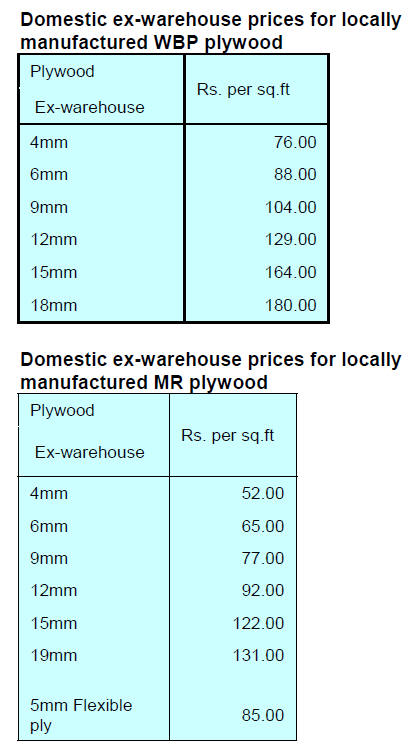
7.
VIETNAM
Wood and Wood Product
(W&WP) trade highlights
Vietnam's exports of W&WP to South Korea in September
2022 are estimated at US$65.4 million, up 32% compared
to September 2021.
In the first 9 months of 2022 exports of wood and wood
products to the Korean market are estimated at US$742
million, up 14% over the same period in 2021.
In September 2022 exports of bedroom furniture reached
US$150 million, up over 200% compared to September
2021. In the first 9 months of 2022 exports of bedroom
furniture are estimated at US$1.8 billion, up 14% over the
same period in 2021.
Vietnam's imports of doussie in September 2022 reached
36,900 cu.m, worth US$15.3 million, down 8% in volume
and 9% in value compared to August 2022. Compared to
September 2021 imports increased by 95% in volume and
121% in value.
In the first 9 months of 2022 doussie imports reached
264,600 cu.m, worth US$105.3 million, up 25% in volume
and 33% in value compared to same period in 2021.
Imports of raw wood from CPTPP markets have declined
for 10 consecutive months compared to the same period
last year. In August 2022 imports reached 62,850 cu.m,
worth US$22.72 million, up 2% in volume and 1.5% in
value compared to July 2022. Imports were down 8% in
volume but up 20% in value compared to August 2021.
In the first 8 months of 2022 imports of raw wood from
CPTPP markets reached 416,860 cu.m, worth US$148.11
million, down 40% in volume and 18% in value over the
same period in 2021.
Vietnam Wood Trade Fair 2022
The 2022 Vietnam International Woodworking Industry
Fair (Vietnam Wood 2022) will be held in Ho Chi Minh
City from October 18-21, to promote technological
transformation of Vietnam’s wood processing industry.
The show will be both virtual and face-to-face and the
event will be held alongside the Vietnam International
Furniture Accessories, Hardware and Tools (Furnitec
2022) exhibition.
Vietnam Wood 2022 will gather 250 exhibitors from 24
countries and territories. Canada, France, Germany and
Russia are expected to run pavilions at the fair, which
showcases the global value chain of the woodworking
industry.
A series of seminars will be organised within the
framework of the event in which speakers will share their
expertise in the field of technology transformation,
automation trends for the industry, smart solutions for the
wood industry in the digital era and wood material
application in interior design, according to the event’s
organisers.
See:
https://en.vietnamplus.vn/tags/Vietnam-Wood-2022.vnp
Wood pellets
In 2021 wood pellets exports from Vietnam amounted to
3.5 million tonness worth US$413 million. Wood pellet
exports are expected to increase sharply. In the first 6
months of 2022 exports reached nearly 2.4 million tonnes
worth US$354 million. If the pace of growth is maintained
exports for the year may reach US$700 million. Wood
pellets are, projected to enter the group of agricultural and
forest products with an export earnig of over US$1 billion.
Domestic plantations, mostly of fast-growing acacia which
are extensive in Vietnam, are the most important source of
material for wood pellet production. This raw material
includes small diameter wood, branches, tops along with
residues from sawmills, veneer factories, chipping mills
with low quality chips that cannot be otherwise used.
Wood residues are abundant in the Northern region where
many sawmills and wood-based panel factories are in
operation. In the Central coastal areas the raw materials
for wood pellet production is mostly branches, tops, reject
chips and certain volume of solid wood.
Information shared by some companies which are
producing and exporting wood pellet shows that raw
materials for wood pellet from domestically grown
plantations account for over 75% of the total supply.
Shavings, sawdust, crushed chips from imported wood are
also one of the most important inputs for wood pellet
production. This source contributes over 20% of the total
supply of raw wood for the wood pellet industry.
Shavings, sawdust and crushed woodchips are waste and
residues from sawmills and woodworking factories
distributed at major wood industry clusters.
Due to the high cost of transportation domestically grown
wood is often uncompetitive with residues from imported
timbers. Vietnam has over 300 wood pellet production
facilities with about 70-80% concentrated in the central
and northeast of the Northern Region, the Central coastal
with extensive plantations and the Southern region with
highly developed wood processing centres.
8. BRAZIL
Forest+ Amazon
Project for conservation and recovery
Small producers and rural property owners from the nine
states in the Legal Amazon are eligible to benefit from the
Amazon Project, the “Forest+ Conservation” modality.
Selected participants will receive financial incentives for
conservation efforts. This project is a partnership between
the Ministry of Environment (MMA) and the United
Nations Development Program (UNDP).
The selection criteria include beneficiaries with no
environmental violations and that have natural vegetation
protected beyond the minimum required by law.
In addition, candidates need to have the Rural
Environmental Registry (Cadastro Ambiental Rural -
CAR) validated by the competent agency as well as
showing compliance with the other criteria set out in the
public call notice.
Project also aims to identify institutions that work with
natural vegetation recovery projects in the Amazon and
that have the potential to work as partners of the “Forest+
Amazon” Project.
See:
https://www.gov.br/pt-br/noticias/noticias/meioambiente/09/projeto-floresta-amazonia-recebe-inscricoes-namodalidade-conservacao-e-tem-chamada-aberta-para-amodalidade-recuperacao
Exports and sustainable harvesting in the State of
Acre
A study showed that all timber companies in the State of
Acre, one of the main tropical timber producing states in
the Amazon, have permits to operate and are thus legal
entities.
The analyses were carried out by the Logging Monitoring
System (Simex - Sistema de Monitoramento da
Exploração Madeireira) Network formed by four
environmental institutions: the Amazon Institute of People
and the Environment (IMAZON), the Institute for
Conservation and Sustainable Development of the
Amazon (IDESAM), the Institute of Agricultural and
Forest Management and Certification (IMAFLORA) and
the “Centro de Vida” Institute (ICV).
Simex analyses were carried out between August 2020 and
July 2021 and recently released data show that, out of the
total of 10,886 hectares of forest in the State of Acre, 94%
of harvesting was on private properties and that there was
no illegal exploitation in restricted areas such as Protected
Conservation Areas or Indigenous Lands.
In August 2022 companies in Acre State exported wood
products valued at US$4.56 million and wood product
imports to the State were valued at US$439,000.
According to the Ministry of Industry, Foreign Trade and
Services the accumulated trade balance for the period
January to August 2022 exceeded that in the same period
in 2021 by 30.2%, totaling US$42.95 million Source: G1
Acre (October 2022).
See:
https://g1.globo.com/ac/acre/noticia/2022/10/01/extracaode-madeira-no-ac-se-concentra-em-areas-privadas-e-esta-100percent-autorizada-aponta-estudo.ghtml
Timber exports from Pará State increase
In Pará State between January and August 2022 the
international trade in wood products registered an increase
of 97% in value (US$273.9 million) and 19.5% in volume
(189,000 tonnes) according to the Association of Timber
Industries Exporters of Pará State (AIMEX).
The United States remains the main destination for wood
products from Pará State followed by France, the
Netherlands, Denmark and Belgium. However, exports in
August dropped to just US$20 million, the worst since
January this year.
AIMEX suggested exchange rate volatility impacted sales,
in addition measures to combat inflation in consumer
countries, the regular lockdowns China and the invasion of
Ukraine by Russia were to blame for the decline in
exports.
See:
https://ver-o-fato.com.br/para-exportacao-de-madeiraaumenta-195-em-volume-e-97-no-faturamento-em-2022/
Export update - corrected
In August 2022 the value of Brazilian exports of woodbased
products (except pulp and paper) declined 2.0%
compared to August 2021 from US$412.6 million to
US$404.6 million.
Pine sawnwood exports grew 8.3% in value between
August 2021 (US$69 million) and August 2022 (US$74.7
million). In volume, exports dropped slightly over the
same period from 255,300 cu.m to 254,200 cu.m.
Tropical sawnwood exports increased 1% in volume, from
35,300 cu.m in August 2021 to 35,700 cu.m in August
2022 and in value exports grew 25% from US$13.0
million to US$16.2 million, over the same period.
Pine plywood exports saw a massive 54% decline in value
in August 2022 compared to August 2021, from US$108.8
million to US$50.5 million. In volume, exports also
dropped 35% over the same period, from 195,900 cu.m to
127,100 cu.m.
As for tropical plywood, the volume of exports also fell
(44%) and in value (34%), from 9,200 cu.m (US$5.6
million) in August 2021 to 5,200 cu.m (US$3.7 million) in
August 2022.
As for wooden furniture exported values fell from
US$66.4 million in August 2021 to US$60.9 million in
August 2022, an 8% drop year on year.
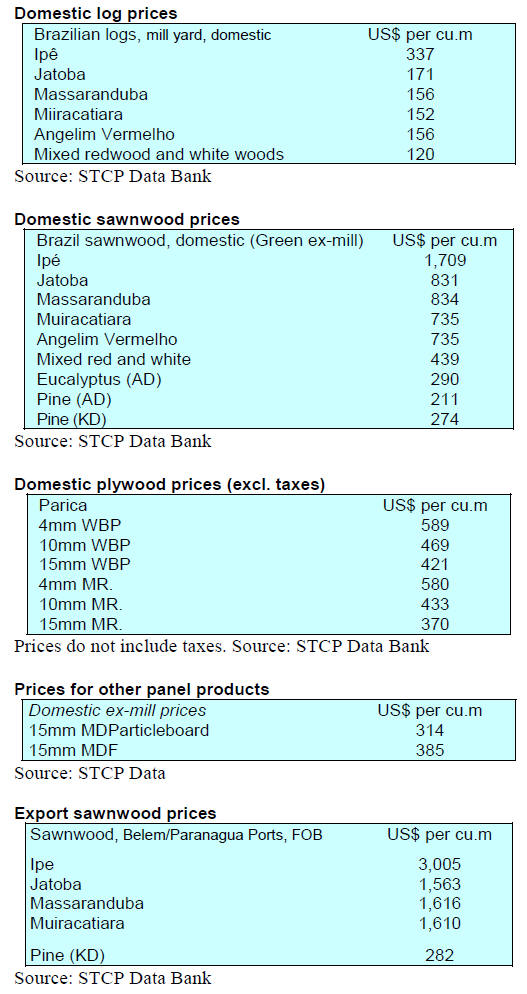
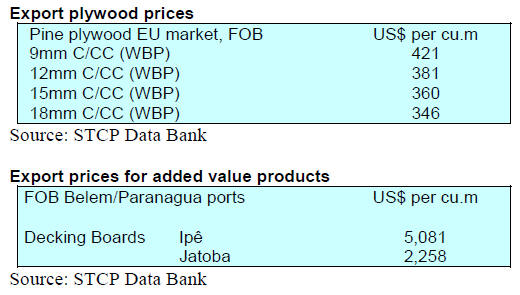
9. PERU
International Wood Fair
From 10-12 November the International Machinery,
Equipment and Services for the Wood and Furniture
Industry Fair – FENAFOR will be held. FENAFOR is the
only international fair in Peru for machinery, supplies,
accessories and services for the forestry, wood and
furniture industries and has been held since 2006.
To date, the organisers report that the Fair will have the
participation of an interesting number of foreign
companies and that the international invitations exceeded
all expectations.
During the event there will be technical presentations by
Peruvian and foreign specialists. Among the topics to be
discussed will be how to take advantage of low-impact
harvesting with a good level of transformation to added
value products.
Private sector initiatives in forest ecosystems
protection acknowledged
The Reforestamos and AIDER associations conducted the
second ‘Los Bóscares Peru’ in September which promotes
the recognition of business practices that support forest
sustainability in the country.
Publicly available information from 169 companies in the
country was analysed from which initiatives by four
companies were selected for assessment. The initiatives of
the finalist companies were evaluated by a jury made up of
the Ministry of the Environment (MINAM), the National
Forestry and Wildlife Service (SERFOR) and two experts
in the forestry sector of Peru.
The winning companies in each of the categories were:
Forests and Climate Change
ISA REP, for its “Jaguar Connection Program in
Alto Huayabamba and Biored Ucayali”.
Forest Conservation
BBVA-BBVA Foundation for its initiative
“Inventory of large Amazonian trees in the Las
Piedras river basin, Madre de Dios”.
Research and Innovation in Forests
Bosques Amazónicos (BAM), for its "State-ofthe-
Art Forest Genetic Improvement Program."
The award ceremony was held virtually so as to connect
with audiences from different sectors of society interested
in learning about the work carried out by companies to
improve their relationship with Peru's forests.
Andean countries fight against illegal logging
With the aim of promoting discussions on illegal logging
in member states of the Andean sub-region the Peruvian
Andean parliamentarian, Juan Carlos Ramírez, presented
the draft regulatory framework for the fight against illegal
logging and trade of wood in the Amazonian forests of the
Andean region.
It is expected that this draft if adopted will improve
coordination between the forestry authorities of the
Andean Parliament countries and will achieve timely
access to information and exchange of experiences.
The Regulatory Framework for the fight against illegal
logging will be reviewed and debated by the Andean
parliamentarians who are members of the Fourth
Commission, which will convene experts in the field to
receive their contributions. Subsequently, the law will go
to the plenary session of the Andean Parliament where it
will be debated further.
